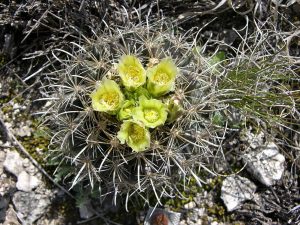Less can be More with Some Rare Species

Flowers of Tobusch fishhook cactus can be yellowish-green (or golden-yellow or bright yellow – not shown).
This is Passport to Texas
Sometimes the best course of action is no action at all. At least that’s the stance botanist, Jackie Poole, takes when it comes to the endangered Tobusch Fishhook Cactus and the insect grubs that eat it.
And that’s a real problem, because one of these insects is only known to lay its eggs in Tobusch Fishhook Cactus; so, it’s basically as rare as the cactus.
In the case of the Tobusch cactus – and its nemesis the Tobusch weevil – the best botanists can do is observe.
We’ve just been studying it for the last 10 or 15 years to see if there’s some kind of cyclical nature to this predator/prey relationship—where you have a big prey population buildup, like a lot of Tobusch fishhook cactus are out there, and then all of a sudden the insect population starts to boom because it has so many cactus to lay its eggs in. And then the cactus goes away and then it crashes, and then you just go through this cycle back and forth.
Other variables could also come into play to explain these fluctuations; making a hasty solution no solution at all. Patience is necessary.
That’s right. And that’s the main thing I think with endangered species. I often tell people to just to take a deep breath, because you just need to sit back and think about it and look at it and not think that the sky is falling.
Learn about rare and endangered plants on the Texas parks and Wildlife website.
The Wildlife Restoration program supports our series.
For Texas Parks and Wildlife, I’m Cecilia Nasti.


 Passport to Texas is a
Passport to Texas is a  Passport to Texas is made available by:
Passport to Texas is made available by: